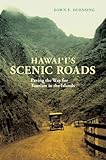Hawai‘i’s Scenic Roads : Paving the Way for Tourism in the Islands / Dawn E. Duensing.
Material type: TextPublisher: Honolulu : University of Hawaii Press, [2015]Copyright date: 2015Description: 1 online resource (328 p.) : 30 b&w images, 7 mapsContent type:
TextPublisher: Honolulu : University of Hawaii Press, [2015]Copyright date: 2015Description: 1 online resource (328 p.) : 30 b&w images, 7 mapsContent type: - 9780824839284
- 9780824854676
- 388.109969 23
- online - DeGruyter
| Item type | Current library | Call number | URL | Status | Notes | Barcode | |
|---|---|---|---|---|---|---|---|
 eBook
eBook
|
Biblioteca "Angelicum" Pont. Univ. S.Tommaso d'Aquino Nuvola online | online - DeGruyter (Browse shelf(Opens below)) | Online access | Not for loan (Accesso limitato) | Accesso per gli utenti autorizzati / Access for authorized users | (dgr)9780824854676 |
Frontmatter -- Contents -- List of Illustrations -- Preface -- Acknowledgments -- Abbreviations -- Introduction: My View of the Road -- Chapter One. Roads to Civilize a Nation -- Chapter Two. Pathways to “Progress” -- Chapter Three. Hawai‘i Drives Its Way into the Union -- Chapter Four. From Footpath to Freeway -- Chapter Five. Scenic Roads -- Chapter Six. NPS Roads on Hawai‘i -- Chapter Seven. Haleakalā Highway -- Epilogue: An Alternate Route through Hawai‘i's History -- Notes -- Glossary of Technical Terms -- Glossary of Hawaiian Words -- Bibliography -- Credits -- Index
restricted access online access with authorization star
http://purl.org/coar/access_right/c_16ec
Hawai‘i's Scenic Roads examines a century of overland transportation from the Kingdom's first constitutional government until World War II, discovering how roads in the world's most isolated archipelago rivaled those on the U.S. mainland. Building Hawai‘i's roads was no easy feat, as engineers confronted a unique combination of circumstances: extreme isolation, mountainous topography, torrential rains, deserts, volcanic eruptions, earthquakes, and on Haleakalā, freezing temperatures. By investigating the politics and social processes that facilitated road projects, this study explains that foreign settlers wanted roads to "civilize" the Hawaiians and promote western economic development, specifically agriculture. Once sugar became the dominant driver in the economy, civic and political leaders turned their attention to constructing scenic roads. Viewed as "commercial enterprises," scenic byways became an essential factor in establishing tourism as Hawai‘i's "third crop" after sugar and pineapple. These thoroughfares also served as playgrounds for the islands' elite residents and wealthy visitors who could afford the luxury of carriage driving, and after 1900, motorcars. Duensing's provocative analysis of the 1924 Hawai‘i Bill of Rights reveals that roads played a critical role in redefining the Territory of Hawai‘i's status within the United States. Politicians and civic leaders focused on highway funding to argue that Hawai‘i was an "integral part of the Union," thus entitled to be treated as if it were a state. By accepting this "Bill of Rights," Congress confirmed the territory's claim to access federal programs, especially highway aid. Washington's subsequent involvement in Hawaii increased, as did the islands' dependence on the national government. Federal money helped the territory weather the Great Depression as it became enmeshed in New Deal programs and philosophy. Although primarily an economic protest, the Hawai‘i Bill of Rights was a crucial stepping stone on the path to eventual statehood in 1959. The core of this book is the intriguing tales of road projects that established the islands' most renowned scenic drives, including the Pali Highway, byways around Kīlauea Volcano, Haleakalā Highway, and the Hāna Belt Road. The author's unique approach provides a fascinating perspective for understanding Hawai‘i's social dynamics, as well as its political, environmental, and economic history.
Mode of access: Internet via World Wide Web.
In English.
Description based on online resource; title from PDF title page (publisher's Web site, viewed 20. Nov 2024)


